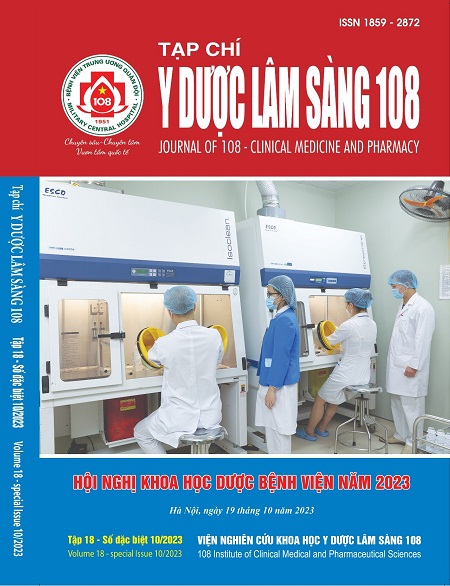So sánh hiệu quả điều trị giữa truyền tĩnh mạch liên tục và ngắt quãng vancomycin thông qua việc theo dõi nồng độ thuốc trong máu tại Bệnh viện Nhi Đồng Thành phố
Main Article Content
Keywords
Tóm tắt
Mục tiêu: So sánh hiệu quả giữa 2 phương pháp truyền tĩnh mạch vancomycin trên đối tượng bệnh nhi trên cơ sở phân tích các chỉ số dược động học/dược lực học, hiệu quả lâm sàng và độ an toàn tại Bệnh viện Nhi Đồng Thành phố. Đối tượng và phương pháp: Nghiên cứu cắt ngang mô tả, từ tháng 03/2022 đến hết tháng 09/2022 tại Bệnh viện Nhi Đồng Thành phố. Bệnh nhân áp dụng quy trình theo dõi nồng độ vancomycin trong trị liệu, chia thành 2 nhóm: Nhóm 1 là truyền ngắt quãng, nhóm 2 là truyền liên tục và được điều chỉnh liều theo kết quả nồng độ vancomycin. Kết quả: Có 52 bệnh nhân đủ điều kiện tham gia nghiên cứu, trong đó 32 bệnh nhân truyền ngắt quãng (nhóm 1) và 20 bệnh nhân truyền liên tục (nhóm 2). Kết quả vi sinh, tỷ lệ tử vong, tỷ lệ xảy ra độc tính trên thận là tương đương nhau. Nhóm 2 đạt được nồng độ mục tiêu nhanh hơn (19 giờ so với 48 giờ, p<0,001), tỷ lệ đạt AUC24 mục tiêu ngay lần đầu cao hơn (60% so với 28,1%, p=0,023), tổng liều duy trì hằng ngày thấp hơn (trung vị liều là 60mg/kg/ngày so với 80mg/kg/ngày), số lần điều chỉnh liều ít hơn (0 so với 1) so với nhóm 1. Tỷ lệ tử vong liên quan đến nhiễm trùng của 2 nhóm là 0%. Tỷ lệ xảy ra độc tính trên thận ở nhóm 1 cao hơn nhóm 2 (6,3% và 0%) (p=0,517). Tỷ lệ xảy ra hội chứng người đỏ ở nhóm 1 cao hơn nhóm 2 (21,9% và 0%) (p=0,035). Kết luận: Ở trẻ em, truyền liên tục vancomycin có khả năng đạt được nồng độ mục tiêu trong máu nhanh hơn so với truyền ngắt quãng. Tổng liều vancomycin yêu cầu hàng ngày để đạt được mục tiêu thấp hơn khi sử dụng phương pháp truyền liên tục. Tuy nhiên, không có sự khác biệt về tỷ lệ xảy ra độc tính trên thận liên quan đến vancomycin ở 2 nhóm.
Article Details
Các tài liệu tham khảo
2. Demirel B, İmamoglu E, Gursoy T et al (2015) Comparison of intermittent versus continuous vancomycin infusion for the treatment of late-onset sepsis in preterm infants. J Neonatal Perinatal Med 8(2):149-155.
3. Girand HL (2020) Continuous infusion vancomycin in pediatric patients: A critical review of the Evidence. J Pediatr Pharmacol Ther 25(3): 198-214.
4. Gwee A, Cranswick N, McMullan B et al (2019) Continuous versus intermittent infusions in infants: A randomized controlled trial. Pediatrics 143(2): 20182179.
5. Girand HL (2020) Continuous Infusion Vancomycin in Pediatric Patients: A Critical Review of the Evidence. J Pediatr Pharmacol Ther 25(3): 198–214.
6. Hutschala D, Kinstner C et al (2009) Influence of vancomycin on renal function in critically ill patients after cardiac surgerycontinuous versusintermittent infusion. Anesthesiology 111(2): 356-365.
7. Matthews Z (2001) Vancomycin continuous infusion: A cohort of 23 intensive care unit patients. Aust J Hosp Pharm 31(2): 108-110.
8. McKinzie CJ, Esther CR, Vece TJ (2018) Continuous vancomycin in a pediatric cystic fibrosis patient. Pediatr Pulmonol 53(1): 4-5.
9. Rybak MJ, Le J et al (2020) Therapeutic monitoring of vancomycin for serious methicillin-resistant Staphylococcus aureus infections: A revised consensus guideline and review by the American Society of Health-System Pharmacists, the Infectious diseases Society of America, the Pediatric Infectious Diseases Society, and the Society of Infectious Diseases Pharmacists. Am J Health Syst Pharm 7: 335-864.
10. Tafelski S, Nachtigall L et al (2015) Observational clinical study on the effects of different dosing regimens on vancomycin target levels in critically ill patients: Continuous versus intermittent application. J Infect Public Health 8(4): 355-363.
11. Wysocki M, Delatour F, Faurisson F et al (2001) Continuous versus intermittent infusion of vancomycin in severe staphylococcal infections: prospective multicenter randomized study. Antimicrob Agents Chemother 45(9): 2460-2467.
 ISSN: 1859 - 2872
ISSN: 1859 - 2872
